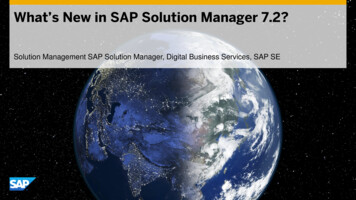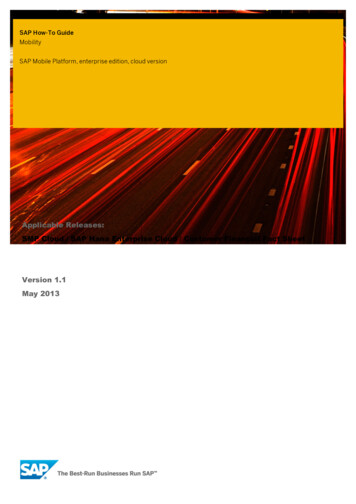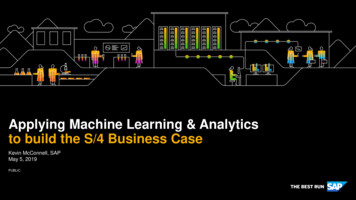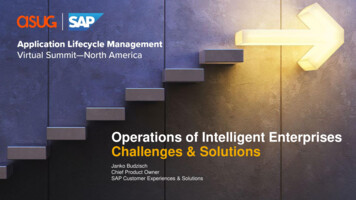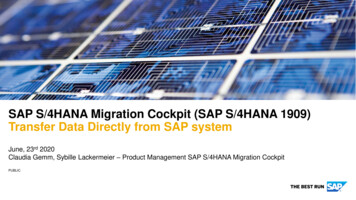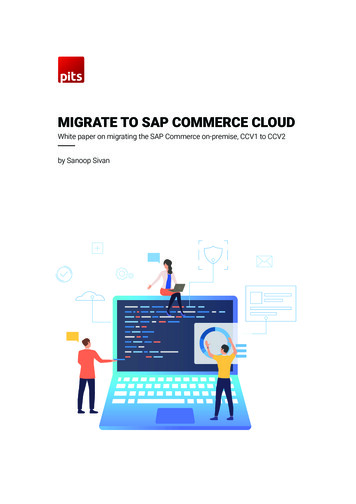
Transcription
MIGRATE TO SAP COMMERCE CLOUDWhite paper on migrating the SAP Commerce on-premise, CCV1 to CCV2by Sanoop Sivan
What is cloud ?Cloud has been the crush in the technology world for someamount of time but the technical world understood its beauty in recent times only and along with others SAP also fell inlove with it. So basically this cloud computing is nothing butstoring and accessing data and programs over the Internet instead of the local computer‘s hard drive and thus accessing itover the internet anywhere, anytime.Cloud provides three types of solutions :1. Software as a Service (SaaS)In this model, the third party provider hosts applications and make them available to customers overthe internet. A majority of the Saas applications rundirectly through the web browser, which means theydon‘t need any local installations etc.Eg: JIRA, Dropbox2. Platform as a Service (PaaS)It refers to cloud-based platform services that provide developers with a framework they can use tobuild custom applications. Thus PaaS isn‘t delivering software over the internet, but it is providing anonline plattform that‘s accessible to different developers to create softwares that then delivered overthe internet. Eg: Google App Engine, Heroku3. Infrastructure as a Service (IaaS)It refers to cloud-based infrastructure resources thatare delivered to organizations via virtualization technology. So IaaS customers can control their own infrastructure without having to phisically manage inonsite, instead use a dashboard or an API.Eg: AWS, Microsof azure2
What is SAP Commerce Cloud ?SAP Commerce Cloud is one among the various aspects of SAP C/4Hana, which expands to SAP’s 4th generation CRM named Hana. Itsalready been a couple of years since SAP launched the SAP CommerceCloud, which is nothing but the SAP Commerce Hybris Platform but alsosupports to be deployed into the cloud infrastructure.SAP Commerce Cloud is one of the solutions that is driving the digitaltransformation, thus it simplifies the digital transformation, reduces thetotal cost of ownership and accelerates time to value. It assists in building B2B, B2C and B2B2C with its single stack architecture. It can integrate all digital and physical customer touchpoints onto a single, robustplatform- including online, mobile, point of sale, call centre, social mediaand print, creating a seamless customer experience. It also offers maximum flexibility for extension and customization. Thus it has everythingin it to help its customers win the global digital marketplace.SAP Commerce cloud supports the following modes to helpthe customers to bring their version of commerce to the end users: On premise InstallationSap Commerce Cloud in SAP infrastructure (CCV1)Sap Commerce Cloud in the public cloud (CCV2)3
Why CCV2 ?The Sap Commerce Cloud in the public cloud is a SaaS Solution provded by SAP. It is also referred as CCV2, which expands to SAP Commerce Cloud Version 2. There are a lot of advantages that make the CCV2a very good deal, the below image shows the key differences of CCV2with its predecessors.On PremiseCCV1CCV2Total Cost ofOwner shipHighMediumLowOnboardingProcess need to be followedfor the creation of environmentProcess need to be followedfor the creation of environmentImmediate access to theenvironmentsVPNNeed to access the environmentNeed to access the environmentCan be accessed over internetanytime, from anywhereRecoveryand BackupNeed help from hosting partnerNeed help from SAPCustomer or Parnter can do itSelf Patch LevelSoftware UpdateManual work is neededManual work is neededAutomatic4
How to migrate from On-Premise,CCV1 to CCV2A customer can migrate their projects that are currently running in onpremise and CCV1 to CCV2 with the help of a good partner. SAP will alsoassist in this process in order to ensure the quality of the solution thatthey will be hosting. The best proven approach for this migration is todivide the project into multiple phases:Discover Introduction of SAP Commerce CloudWorkshop with SAP, partner and CustomerMigration AssessmentsEstimation and PlanningDevelop Env setup DEV, STG, PRODCode AdaptationDatabase and media migration (DEV &STRG)Lift and shift (DEV STG)Build and deploy (DEV STG)Cloud Readiness Check Milestone 1Test Performance testingUser acceptanceBug fixingCloud Readiness Check Milestone 2Live Database and media migration (PROD)Lift and shift (PROD)Build and deploySmoke Testing5
DurationStarting with the assessment, which will take a max of 7 to 10 days,then the detailed plan will be presented to the customer. Once the customer agrees to the plan, it would ideally take 2 to 4 months to finishthe successful migration to go live with the new cloud solution.The detailed recommended phases for the migration are follows:DiscoverThis is the initial phase in which, the introduction ofsap commerce cloud will take place and alsoworkshop along with the customer, partner and theSAP will also be conducted.The next main objective of this phase is the migration assessments for the existing solution and the estimate created based onthis assessment. Migration AssessmentThe partner with some assistance from SAP will assess thecurrent solution and will create a detailed plan, effort and costlevel estimate for the migration project. Ideally it will take 2 ormore months to migrate a project based on the complexityof the customization already done to it. Some of the coreassessment topics that are directly proportional to thetimeline are: GITThe CCV2 only support GIT versioning at the moment.So if the current project is not in GIT, we need to migrate itto GIT first or use a job to move the changes to GIT everytime for a deployment and take it from there, the solutiontotally depends upon the infrastructure needed by thecustomer.6
SAP Commerce VersionThe solution needs to be first migrated to a SAP Commerce version that the CCV2 is compatible with. The recommended version is 1905, but CCV2 is supported fromversion 6.7 onwards. PCI ComplianceCurrently, SAP Commerce Cloud in the Public Cloud is notcertified for PCI-DSS 3.2. If this is blocking the project,then it needs to be taken up with SAP. Solr CustomizationIf the current solution is using a highly customizablesearch engine or a third party other than solr, then oneneeds to consider what the CCV2 can offer for this. SMTP serverSAP Commerce Cloud does not currently ship with anSMTP-server or service. But there are solutions for it, thatneed to be considered. Hot folderIf there is an in-place hot folders/NFS/SFTP based integrations, then it need to be moved to the Cloud Hot Folderwhich is using the blob storage of Azure. Integrations / Datahub / DAMMost solutions will have some integrations with a thirdparty or a middleware. So this need to be treated with respect in case of the migration. SAP Cloud supports theseintegration with SCPI, Hot-folders, Datahub, etc7
Build CustomizationIf the current solution is highly customized on the buildpart, then a special treatment is needed to move thatsolution to a more specific way which is supported by thecloud.And more The assessment needs to be thorough and thus will leadto a high level effort and cost estimate.to a high level effort and cost estimate. PlanningNext comes the planning phase, the partner need to comeup with a strategy that will not affect the live solution. So thatwe can migrate it in parallel with the current developmentapproach in an effective way so that the customer thinksthat’s apt for them.DevelopThis is the execution phase where the partner will create theevironments, and then start with the customization of the code.In this phase SAP will do the data and media migration, which thecustomer will need to give SAP the access to the current solutions database, SAP will use their predefined connectors to migrate the data into cloud. Once that is successful, the partner willlift and shift the existing environments to the cloud. Recommendations It is recommended to migrate the development environment first and then the staging environment. The recommended solution has only 3 environments DEV, STG andPROD. PROD migration will happen on the last phase. It is recommended to stop pushing major feature releasesto the current solution after the start of the develop phase.At the end of this phase, SAP can do the readinesscheck Milestone 18
Cloud Readiness Check Milestone 1This check-up is also included in the cloud package, inwhich SAP will do a review on the project setup, includinga high-level review of code and solution designTestThe customer along with the partner will do theperformance and user acceptance testing in thisphase, along with the bug fixes if needed. Then atthe end SAP will do the Cloud Readiness CheckMilestone 2 for the go-live. Cloud Readiness Check Milestone 2Same as milestone 1, but this will be more like a pre-go-livereview focused on a SAP Commerce Cloud application-levelsecurity check, basic application and client-side profiling.DeployThe final phase in which the reviewed, customer approved solutionwill be moved to production along with the database and mediamigration with the help of SAP. Then customer along with thepartner need to do a smoke test, then go live and monitoring of thenew cloud system will be happening. RecommendationsOnce this phase is started we need to closely monitor the operations which are happening in the current on-premise production, if possible minimize them. After the successful migrationthese changes will need to be synchronized periodically withthe cloud production until the go-live of the cloud.9
Success factorsFor the customers thinking about the migration of on-premise,CCV1 SAP solution to the CCV2, there are a lot of factors that needto be taken into account — from the benefits and the risks to thecost and duration that is right for your business.The main factor that makes this migration truly successful is choosing an expert level partner with a customer-centric focus and thecollaboration with them throughout the entire project.Let’s get this done.Contact Us: thomas@pitsolutions.com10
SAP Commerce Cloud is one among the various aspects of SAP C/4 . which is nothing but the SAP Commerce Hybris Platform but also supports to be deployed into the cloud infrastructure. SAP Commerce Cloud is one of the solutions that is driving the digital . B2C and B2B2C with its single stack architecture. It can integ-rate all digital and .


